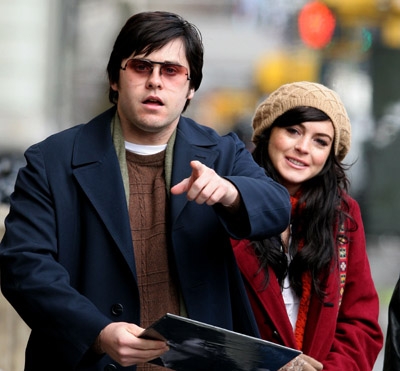

Reviews of Recent Independent, Foreign, & Documentary Films in Theaters and DVD/Home Video
Written & Directed by Jarrett Schaefer, inspired by the book Let Me Take You Down by Jack Jones Produced by Robert Salerno, Naomi Despres, & Alexandra Milchan Director of Photography, Tom Richmond Edited by Jim Makiej & Andrew Hafitz Music by Anthony Marinelli Released by Peace Arch Entertainment USA. 85 min. Rated R With Jared Leto, Lindsay Lohan & Judah Friedlander There are occasional moments of serendipity or accident when two films exploring the same material emerge during a single season. (The recent portrayals of Truman Capote in Capote and Infamous come to mind). It’s impossible, seeing two such films within the space of a couple of months, not to compare and contrast. Chapter 27 and Andrew Piddington’s The Killing of John Lennon both explore the deranged world of Mark David Chapman, who murdered John Lennon outside of his apartment building on December 8, 1980. The two films feature deeply disturbing and effective lead performances. In Piddington’s film, relative unknown Jonas Ball delivers an intense portrayal of The Catcher in the Rye-obsessed Chapman as a manic, fast-talking control freak, whose unchecked fury leads him inexorably to kill. In Schaefer’s version, an unrecognizably bloated Jared Leto embodies a repulsive social misfit whose descent into madness is more mystifying, but no less convincing. Both portrayals rely heavily on Chapman’s actual words, and it’s fascinating to see how very dissimilar the two “Chapmans” are. Leto, who gained 60 pounds for the role and adopts a drawl that’s uncannily reminiscent of Capote’s Philip Seymour Hoffman’s portrayal of the author, will be an Oscar hopeful, if the film is not forgotten at year’s end. However, it’s in the writing, staging, conceptualization, and supporting performances that Piddington’s work outshines Chapter 27. Piddington’s script intricately connects Chapman’s story to the broader social context of his life, deeply exploring issues of celebrity, sexuality, race, capitalism, and history. We learn, for example, that Chapman killed John Lennon almost incidentally – there were several other celebrities he felt he could have killed instead, to serve out his manic, delusional mission: “The phony must die, says the Catcher in the Rye.” Schaefer’s movie tells the story in more pat, expected ways, with the richer historical and biographical source material largely excluded. His Chapman meets some groupies outside of the Dakota, Lennon’s apartment building, as in John Lennon and in real life, but Chapter 27 introduces Jude (Lindsay Lohan), whose innocence is more cloying than believable. The meaningless Hollywood interludes between her and Chapman eat valuable screen time that could have addressed the complexities of Chapman’s personality. The fact that Chapman, like John Lennon, was married to an Asian woman was subtly and intricately considered in John Lennon, as was his obsession with Raging Bull and Taxi Driver. Though the tabloid photographer Chapman talks to outside of the Dakota is hilariously portrayed by Judah Friedlander, his punch lines aren’t quite appropriate for the momentum of the film. Other than Leto’s believable Chapman, the characters in Chapter 27 seem like actors, and the film often feels staged.
The gritty verity of John Lennon makes it the more interesting movie, but both are worth seeing for the strong lead performances and the
thought-provoking story. Also, one place that John Lennon slips up where Chapter 27 succeeds is in the depiction of the murder –
it happens off-screen, with the sound of gunshots and a woman’s agonized wail. It’s a reminder that this actually happened, that
Chapman’s illness went unchecked. Hopefully, rather than obscuring The Killing of John Lennon, Chapter 27 will intrigue viewers enough
to lead them to seek out Piddington’s stronger, more innovative treatment.
Elizabeth Bachner
|